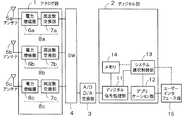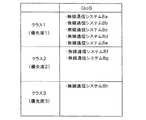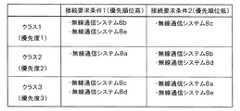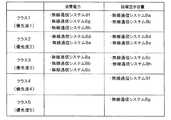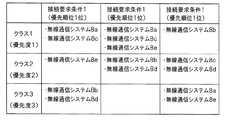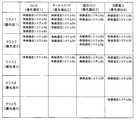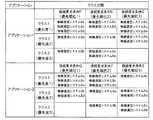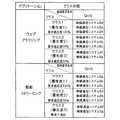JP2005109722A - Wireless communication apparatus and wireless communication method - Google Patents
Wireless communication apparatus and wireless communication methodDownload PDFInfo
- Publication number
- JP2005109722A JP2005109722AJP2003338350AJP2003338350AJP2005109722AJP 2005109722 AJP2005109722 AJP 2005109722AJP 2003338350 AJP2003338350 AJP 2003338350AJP 2003338350 AJP2003338350 AJP 2003338350AJP 2005109722 AJP2005109722 AJP 2005109722A
- Authority
- JP
- Japan
- Prior art keywords
- wireless communication
- class
- connection request
- communication system
- wireless
- Prior art date
- Legal status (The legal status is an assumption and is not a legal conclusion. Google has not performed a legal analysis and makes no representation as to the accuracy of the status listed.)
- Pending
Links
Images
Classifications
- H—ELECTRICITY
- H04—ELECTRIC COMMUNICATION TECHNIQUE
- H04W—WIRELESS COMMUNICATION NETWORKS
- H04W48/00—Access restriction; Network selection; Access point selection
- H04W48/16—Discovering, processing access restriction or access information
- H—ELECTRICITY
- H04—ELECTRIC COMMUNICATION TECHNIQUE
- H04W—WIRELESS COMMUNICATION NETWORKS
- H04W36/00—Hand-off or reselection arrangements
- H04W36/16—Performing reselection for specific purposes
- H—ELECTRICITY
- H04—ELECTRIC COMMUNICATION TECHNIQUE
- H04W—WIRELESS COMMUNICATION NETWORKS
- H04W8/00—Network data management
- H04W8/22—Processing or transfer of terminal data, e.g. status or physical capabilities
Landscapes
- Engineering & Computer Science (AREA)
- Computer Security & Cryptography (AREA)
- Computer Networks & Wireless Communication (AREA)
- Signal Processing (AREA)
- Mobile Radio Communication Systems (AREA)
- Transceivers (AREA)
Abstract
Translated fromJapaneseDescription
Translated fromJapanese本発明は、それぞれ異なる無線方式で無線通信を行う複数の無線方式を備えた無線通信装置に関する。 The present invention relates to a wireless communication apparatus including a plurality of wireless systems that perform wireless communication using different wireless systems.
複数の無線通信システムを備えた無線通信装置が提案されている(特許文献1、特許文献2参照)。特許文献1の無線通信装置は、複数の無線通信システムを優先順位を付けて分類したテーブルに従って、いずれかの無線通信システムを選択する。これらの特許文献に開示された従来の無線通信装置は、特定の接続要求条件、例えば通信コストを優先して通信路を選択するものである。
従来は、特定の接続要求条件のみで無線通信システムを選択していたため、複数の接続要求条件を考慮に入れて最適な無線通信システムを選択することができなかった。 Conventionally, since a radio communication system is selected only with specific connection request conditions, it is not possible to select an optimal radio communication system in consideration of a plurality of connection request conditions.
また、従来は、複数の無線通信システムに対して一意に優先順位を付けていたため、優先順位が低いが十分な通信品質が保てる無線通信システムが存在しても、優先順位の高い無線通信システムが無条件に選択され、不必要なハンドオーバーが多く発生するという問題があった。 Conventionally, since priority is uniquely assigned to a plurality of wireless communication systems, even if there is a wireless communication system with low priority but sufficient communication quality, there is a wireless communication system with high priority. There was a problem that unnecessarily selected and many unnecessary handovers occurred.
本発明は、このような問題点に鑑みてなされたものであり、その目的は、接続要求条件に応じて複数の無線方式のいずれかを的確に選択可能な無線通信装置および無線通信方法を提供することにある。 The present invention has been made in view of such problems, and an object of the present invention is to provide a wireless communication apparatus and a wireless communication method capable of accurately selecting one of a plurality of wireless systems according to connection request conditions. There is to do.
上記の目的を達成するため、本発明は、無線通信可能な複数の無線方式のうち、いずれかの無線方式を選択して無線通信を行う無線通信手段と、少なくとも一つの接続要求条件に基づいて前記複数の無線方式に優先順位が付けられ、該優先順位に基づいて前記複数の無線方式を複数のクラスに分類した情報を記憶する記憶手段と、前記記憶手段に記憶されたクラスに基づいて、前記無線通信手段が無線通信を行う無線方式を選択する選択手段と、を備える。 In order to achieve the above object, the present invention is based on at least one connection request condition and wireless communication means for performing wireless communication by selecting one of a plurality of wireless systems capable of wireless communication. Based on the classes stored in the storage unit, the storage unit storing information in which the plurality of wireless systems are prioritized, and the plurality of wireless systems are classified into a plurality of classes based on the priority. Selecting means for selecting a wireless method for performing wireless communication by the wireless communication means.
本発明によれば、複数の無線方式を複数のクラスに分類して、優先順位の高いクラスに属する無線方式を選択するため、種々の接続要求条件に最適な無線方式を選択できる。 According to the present invention, since a plurality of radio systems are classified into a plurality of classes and a radio system belonging to a class having a higher priority is selected, a radio system optimal for various connection request conditions can be selected.
以下、図面を参照して、本発明の一実施形態を説明する。 Hereinafter, an embodiment of the present invention will be described with reference to the drawings.
(第1の実施形態)
図1は本発明に係る無線通信装置の一実施形態の概略構成を示すブロック図である。図1の無線通信装置は、アナログの無線信号を処理するアナログ部1と、デジタルの無線信号を処理するディジタル部2と、A/D&D/A変換器3と、送受信を切り替える切替部4とを備えている。(First embodiment)
FIG. 1 is a block diagram showing a schematic configuration of an embodiment of a wireless communication apparatus according to the present invention. 1 includes an
アナログ部1は、複数の無線通信システムそれぞれに対応して、アンテナ5a,5b,5cと、電力増幅器6a,6b,6cと、周波数変換部7a,7b,7cとを有する。なお、図1は3つの無線通信システム8a,8b,8cを有する例を示すが、無線通信システムの数に特に制限はない。以下では、複数の無線通信システム8a,8b,8cを総称して無線通信システム8と呼び、複数のアンテナ5a,5b,5cを総称してアンテナ5と呼び、複数の電力増幅器6a,6b,6cを総称して電力増幅器6と呼び、複数の周波数変換部7a,7b,7cを総称して周波数変換部7と呼ぶこともある。 The
ディジタル部2は、ディジタル信号処理部11と、アプリケーション部12と、システム選択制御部13と、メモリ14とを有し、システム選択制御部13にはユーザーインタフェース部15が接続されている。 The
次に、図1の無線通信装置の動作を説明する。まず、通信開始時に、システム選択制御部13は、アプリケーション部12とユーザーインタフェース部15からの情報を基に、通信に使用する無線通信システム8を選択する。システム選択制御部13で使用する無線通信システム8が選択されると、例えば、メモリ14から選択された無線通信システム8の機能を実現するソフトウエアがディジタル信号処理部11にダウンロードされ、ディジタル信号処理部11は選択した無線通信システム8の機能を実現する。また、アナログ部1は、使用する無線通信システム8に対応する電力増幅器6と周波数変換部7を選択し、切替部4を介してA/D&D/A変換器3に接続される。 Next, the operation of the wireless communication apparatus in FIG. 1 will be described. First, at the start of communication, the system
ここで、システム選択制御部13が選択した無線通信システムが無線通信システム8bとすると、アナログ部1のアンテナ5b、電力増幅器6bおよび周波数変換部7bが選択される。 Here, if the wireless communication system selected by the system
この状態で、データを受信する場合、アンテナ5bに入力された受信データは電力増幅器6bで増幅されて、周波数変換部7bでベースバンド信号に変換された後、A/D&D/A変換器3に入力される。A/D&D/A変換器3でアナログ信号からディジタル信号に変換された後、ディジタル信号処理部11で選択した無線通信システム8の符号化処理に対する復号処理が行われる。復号されたデータは、アプリケーション部12に入力され、アプリケーションに応じた処理がなされた後、ユーザーインタフェース部15に入力されてユーザーへと伝達される。 In this state, when data is received, the received data input to the
また、CRC符号などの誤り検出符号が付加されるような無線通信システム8のデータは、ディジタル信号処理部11で復号処理された後、同ディジタル信号処理部11で誤り検出処理が行われ、誤り検出結果はシステム選択制御部13に送られる。システム選択制御部13では、ディジタル信号処理部11から送られた誤り検出結果を管理し、他システムへのハンドオーバーの要否を判断する。 Further, data of the
一方、データを送信する場合、ユーザーインタフェース部15で入力されたユーザーの要求が、アプリケーション部12に入力されてアプリケーションに応じた処理がなされた後、ディジタル信号処理部11に入力され、選択した無線通信システム8bの符号化処理が行われる。ディジタル信号処理部11で符号化されたデータはA/D&D/A変換器3に入力されてアナログ信号に変換された後、周波数変換部7bでRF周波数に周波数変換されて、アンテナ5bから出力される。 On the other hand, when data is transmitted, a user request input by the
図2はシステム選択制御部13の内部構成の一例を示すブロック図である。図示のように、システム選択制御部13は、接続要求条件に基づいて複数の無線通信システム8を複数のクラスに分類したテーブルを作成するクラス分類部17と、複数のクラスに分類された複数の無線通信システム8の中から一つを選択する選択部18とを有する。 FIG. 2 is a block diagram showing an example of the internal configuration of the system
複数の無線通信システム8は、それぞれの優先順位に応じて複数のクラスに分類される。クラス1には最も優先順位が高い無線通信システム8が分類され、クラス2には次に優先順位が高い無線通信システム8が分類され、クラス3には最も優先順位が低い無線通信システム8が分類される。 The plurality of
図3はクラス分類部17の処理手順の第1例を示すフローチャートである。まず、対象とする無線通信システム8がクラス1の基準を満たすか否かを、特定の接続要求条件に対する優先順位に基づいて判定する(ステップS1)。クラス1の基準を満たす場合には、この無線通信システム8をクラス1に分類する(ステップS2)。 FIG. 3 is a flowchart showing a first example of the processing procedure of the
クラス1の基準を満たさない場合には、クラス2の基準を満たすか否かを優先順位に基づいて判定する(ステップS3)。クラス2の基準を満たす場合には、この無線通信システム8をクラス2に分類する(ステップS4)。 If the
クラス2の基準を満たさない場合には、クラス3の基準を満たすか否かを判定し(ステップS5)、クラス3の基準を満たす場合には、この無線通信システム8をクラス3に分類する(ステップS6)。 If the
図4は図3の処理に従ってクラス分類部17が作成したテーブルの一例を示す図であり、5種類の無線通信システム8a〜8eを分類する例を示している。優先順位が最も高いクラス1には無線通信システム8b,8eが分類され、その次に優先順位が高いクラス2には無線通信システム8aが分類され、最も優先順位が低いクラス3には無線通信システム8c,8dが分類される。 FIG. 4 is a diagram showing an example of a table created by the
図5は図4のテーブルが作成された場合に選択部18が行う処理手順の第1例を示すフローチャートである。まず、クラス1に属する無線通信システム8が存在するか否かを判定し(ステップS11)、存在する場合には、クラス1に属する無線通信システム8の中から一つを選択する(ステップS12)。ここで、クラス1に複数の無線通信システム8が存在する場合には、他の接続要求条件に基づいていずれか一つの無線通信システム8を選択する。 FIG. 5 is a flowchart showing a first example of a processing procedure performed by the
クラス1に属する無線通信システム8が存在しない場合には、クラス2に属する無線通信システム8が存在するか否かを判定し(ステップS13)、存在する場合には、クラス2に属する無線通信システム8の中から一つを選択する(ステップS14)。 If there is no
クラス2に属する無線通信システム8が存在しない場合には、クラス3に属する無線通信システム8が存在するか否かを判定し(ステップS15)、存在する場合には、クラス3に属する無線通信システム8の中から一つを選択する(ステップS16)。 If there is no
図6は接続要求条件を通信品質QoS(Quality of Service)としてクラス分類した場合のテーブルの一例を示す図である。8つの無線通信システム8a〜8hのうち5つの無線通信システム8a〜8eがクラス1に分類され、無線通信システム8f,8gがクラス2に分類され、無線通信システム8hがクラス3に分類されている。 FIG. 6 is a diagram illustrating an example of a table when the connection request conditions are classified as communication quality QoS (Quality of Service). Of the eight
なお、図4や図6では、3つのクラス1〜3に分類する例を説明したが、クラスの数に特に制限はない。 4 and 6, the example of classifying into the three
このように、第1の実施形態では、接続要求条件に従って複数の無線通信システム8に優先順位を付けて複数のクラスに分類し、最も優先順位が高いクラス1に属する無線通信システム8の中からいずれか一つの無線通信システム8を選択するため、接続要求条件に適した無線通信システム8を選択できる。 As described above, in the first embodiment, priorities are assigned to a plurality of
(第2の実施形態)
第2の実施形態は、2つの接続要求条件ごとに複数の無線通信システム8を複数のクラスに分類するものである。(Second Embodiment)
In the second embodiment, a plurality of
無線通信装置の第2の実施形態は、図1と同様の構成を備えている。図7はクラス分類部17が作成したテーブルの一例を示す図である。クラス分類部17は、接続要求条件1,2のそれぞれについて、図3と同じ処理を行って図7のテーブルを作成する。 The second embodiment of the wireless communication apparatus has the same configuration as that of FIG. FIG. 7 is a diagram illustrating an example of a table created by the
図7に示すように、接続要求条件1に基づいてクラス分類を行うと、最も優先順位の高いクラス1には無線通信システム8b,8eが分類され、次に優先順位の高いクラス2には無線通信システム8aが分類され、最も優先順位の低いクラス3には無線通信システム8c,8dが分類される。また、接続要求条件2に基づいてクラス分類を行うと、クラス1には無線通信システム8cが分類され、クラス2には無線通信システム8b,8dが分類され、クラス3には無線通信システム8a,8eが分類される。 As shown in FIG. 7, when class classification is performed based on
使用する無線通信システム8を選択するにあたり、まず、接続要求条件1によるクラス分類により、優先順位の最も高いクラス1に属する無線通信システム8bと無線通信システム8eが選択の候補となる。続いて、接続要求条件2によるクラス分類により、無線通信システム8bはクラス2に分類され、無線通信システム8eはクラス3に分類される。よって、接続要求条件1では同一クラスに属するが、接続要求条件2で優先順位の高いクラス2に属する無線通信システム8bが、使用する無線通信システム8として選択される。 In selecting the
このように、2つの接続要求条件1,2に基づいて無線通信システム8を選択するため、複数の接続条件を満たす最適な無線通信システム8を選択できる。 In this way, since the
次に、第2の実施形態の具体例を説明する。図8は、接続要求条件1を消費電力とし、接続要求条件2を回線空き容量として、8つの無線通信システム8a〜8hを5つのクラスに分類したテーブルの一例を示している。 Next, a specific example of the second embodiment will be described. FIG. 8 shows an example of a table in which the eight
図8では、接続要求条件1である消費電力に基づいて、無線通信システム8f,8g,8hがクラス1に、無線通信システム8d,8eがクラス2に、無線通信システム8a,8b,8cがクラス3に分類される。このクラス分類の基準は、例えば、クラス1は消費電力の接続要求条件の基準を完全に満たす無線通信システム、クラス2は消費電力の接続要求条件の基準を完全に満たさないが多少下回る無線通信システム、クラス3は消費電力の接続要求条件の基準を大幅に下回る無線通信システム、という基準である。また、この例では無線通信システム8を3つのクラスに分類したが、必ずしも3つのクラスである必要はなく、さらに多くの或いはさらに少ないクラスに分類してもよい。 In FIG. 8, based on the power consumption that is the
また、図8では、接続要求条件2である回線空き容量に基づいて、無線通信システム8a,8bがクラス1に、無線通信システム8d,8eがクラス2に、無線通信システム8c,8hがクラス3に、無線通信システム8fがクラス4に、無線通信システム8gがクラス5に分類される。 Further, in FIG. 8, based on the available line capacity that is the
このクラス分類の基準は、例えば、クラス1は回線空き容量が90%程度の無線通信システム、クラス2は回線空き容量が70%の無線通信システム、クラス3は回線空き容量が50%の無線通信システム、クラス4は回線空き容量が30%の無線通信システム、クラス5は回線空き容量が10%の無線通信システムという基準である。また、この例では無線通信システム8を5つのクラスに分類したが、必ずしも5つのクラスである必要はなく、さらに多くの或いはさらに少ないクラスに分類してもよい。 The class classification criteria are, for example,
図9は図8のテーブルが作成された場合に選択部18が行う処理手順の第2例を示すフローチャートである。まず、接続要求条件1として消費電力を設定し(ステップS21)、クラス1に属する無線通信システム8が存在するか否かを判定し(ステップS22)、存在する場合には、接続要求条件2として回線空き容量を設定する(ステップS23)。 FIG. 9 is a flowchart showing a second example of a processing procedure performed by the
次に、接続要求条件2に基づいて分類されたクラス1に属する無線通信システム8が存在するか否かを判定し(ステップS24)、存在する場合には、その中からいずれか一つを選択する(ステップS25)。 Next, it is determined whether or not the
ステップS24の判定が否定された場合は、接続要求条件2に基づいて分類されたクラス2に属する無線通信システム8が存在するか否かを判定し(ステップS26)、存在する場合には、その中からいずれか一つを選択する(ステップS27)。 If the determination in step S24 is negative, it is determined whether there is a
ステップS26の判定が否定された場合は、接続要求条件2に基づいて分類されたクラス3に属する無線通信システム8が存在するか否かを判定し(ステップS28)、存在する場合には、その中からいずれか一つを選択する(ステップS29)。 If the determination in step S26 is negative, it is determined whether there is a
ステップS28の判定が否定された場合は、接続要求条件2に基づいて分類されたクラス4に属する無線通信システム8が存在するか否かを判定し(ステップS30)、存在する場合には、その中からいずれか一つを選択する(ステップS31)。 If the determination in step S28 is negative, it is determined whether or not there is a
ステップS30の判定が否定された場合は、接続要求条件2に基づいて分類されたクラス5に属する無線通信システム8が存在するか否かを判定し(ステップS32)、存在する場合には、その中からいずれか一つを選択する(ステップS33)。 If the determination in step S30 is negative, it is determined whether or not there is a
一方、ステップS22で接続要求条件1に基づいて分類されたクラス1に属する無線通信システム8が存在しない場合には、接続要求条件1に基づいて分類されたクラス2に属する無線通信システム8が存在するか否かを判定し(ステップS34)、存在する場合には、ステップS23〜S33の処理を行う。 On the other hand, when there is no
また、ステップS34で接続要求条件1に基づいて分類されたクラス2に属する無線通信システム8が存在しない場合には、接続要求条件1に基づいて分類されたクラス3に属する無線通信システム8が存在するか否かを判定し(ステップS35)、存在する場合には、ステップS23〜S33の処理を行う。 If there is no
このように、第2の実施形態では、2つの接続要求条件ごとに複数の無線通信システム8を複数のクラスに分類し、2つの接続要求条件を考慮に入れて無線通信システム8を選択するため、2つの接続要求条件に最も合致した無線通信システム8を選択できる。 As described above, in the second embodiment, the plurality of
(第3の実施形態)
第3の実施形態は、3つの接続要求条件ごとに複数の無線通信システム8を複数のクラスに分類し、かつこれら接続要求条件に優先順位を付けるものである。(Third embodiment)
In the third embodiment, a plurality of
無線通信装置の第3の実施形態は、図1と同様の構成を備えている。図10はクラス分類部17が作成したテーブルの一例を示す図である。クラス分類部17は、接続要求条件1〜3のそれぞれについて、図3と同じ処理を行って図10のテーブルを作成する。 The third embodiment of the wireless communication apparatus has the same configuration as that of FIG. FIG. 10 is a diagram showing an example of a table created by the
図10に示すように、接続要求条件1に基づいて、最も優先順位が高いクラス1には無線通信システム8a,8cが分類され、次に優先順位が高いクラス2には無線通信システム8eが分類され、最も優先順位が低いクラス3には無線通信システム8b,8dが分類される。また、接続要求条件2に基づいて、クラス1には無線通信システム8a,8c,8eが分類され、クラス2には無線通信システム8b,8dが分類される。また、接続要求条件3に基づいて、クラス1には無線通信システム8bが分類され、クラス2には無線通信システム8c,8dが分類され、クラス3には無線通信システム8a,8eが分類される。 As shown in FIG. 10, based on the
接続要求条件1〜3には優先順位が付けられており、接続要求条件1が最も優先順位が高く、次が接続要求条件2で、接続要求条件3が最も優先順位が低い。 The
使用する無線通信システム8を選択するにあたり、まず、優先順位が最も高い接続要求条件1によるクラス分類を行って、優先順位の最も高いクラス1に属する無線通信システム8a,8cが選択の候補となる。 In selecting the
次に、優先順位が2位の接続要求条件2によるクラス分類によると、無線通信システム8a,8cもクラス1に分類されるため、使用する無線通信システム8はこの段階では決定できない。優先順位が3位の接続要求条件3によるクラス分類により、無線通信システム8cはクラス2に分類され、無線通信システム8aはクラス3に分類される。よって、優先順位が1位の接続要求条件1および優先順位が2位の接続要求条件2では同一クラスに属するが、優先順位が3位の接続要求条件3に基づいて分類された優先順位の高いクラス2に属する無線通信システム8cが、使用する無線通信システム8として選択される。 Next, according to the classification according to the
このように、優先順位が1位の第1の接続要求条件と優先順位が2位の第2の接続要求条件、および優先順位が3位の第3の接続要求条件の、3つの接続要求条件の基準に基づいた無線通信システム8の選択が行われ、複数の接続条件を満たす最適な無線通信システム8を選択できる。 Thus, the three connection request conditions, the first connection request condition with the first priority, the second connection request condition with the second priority, and the third connection request condition with the third priority. The
ここでは、優先順位付けされた3つの接続要求条件1〜3の基準に基づくクラス分類に基づいて無線通信システム8を選択する例を説明したが、接続要求条件は必ずしも3つである必要はなく、これ以上またはこれ以下の優先順位付けされた接続要求条件の基準に基づくクラス分類によって、使用する無線通信システム8を選択してもよい。 Here, an example has been described in which the
以下、第3の実施形態の具体例を説明する。図11は、優先順位が1位の接続要求条件1として通信品質(QoS)を、優先順位が2位の接続要求条件としてサービスエリアを、優先順位が3位の接続要求条件として通信コストを、優先順位が4位の接続要求条件として消費電力を設定し、8つの無線通信システム8a〜8hを5つのクラスに分類したテーブルの一例を示す図である。 Hereinafter, a specific example of the third embodiment will be described. FIG. 11 shows communication quality (QoS) as the
図11では、優先順位が1位の接続要求条件であるQoSの基準にしたがい、無線通信システム8d〜8hがクラス1に、無線通信システム8b,8cがクラス2に、無線通信システム8aがクラス3に分類される。このクラス分類の基準は、例えば、クラス1はQoSの要求条件を完全に満たす無線通信システム、クラス2はQoSの接続要求条件の基準を完全に満たさないが多少下回る無線通信システム、クラス3はQoSの接続要求条件の基準を大幅に下回る無線通信システム、という基準である。また、この例では無線通信システム8を3つのクラスに分類したが、必ずしも3つのクラスである必要はなく、さらに多くの或いはさらに少ないクラスに分類してもよい。 In FIG. 11, the
また、優先順位が2位の接続要求条件であるサービスエリアの基準にしたがい、無線通信システム8a,8d,8e,8hがクラス1に、無線通信システム8c,8fがクラス2に、無線通信システム8b,8gがクラス3に分類される。このクラス分類の基準は、例えば、クラス1はサービスエリアが人口カバー率90%以上の無線通信システム、クラス2はサービスエリアが人口カバー率70%の無線通信システム、クラス3はサービスエリアが人口カバー率50%の無線通信システムという基準である。また、この例では無線通信システム8を3つのクラスに分類したが、必ずしも3つのクラスである必要はなく、さらに多くの或いはさらに少ないクラスに分類してもよい。 Further, according to the service area standard, which is the connection request condition with the second highest priority, the
続いて、優先順位が3位の接続要求条件である通信コストの基準にしたがい、無線通信システム8a,8bがクラス1に、無線通信システム8d,8e,8gがクラス2に、無線通信システム8c,8hがクラス3に、無線通信システム8fがクラス4に分類される。このクラス分類の基準は、例えば、クラス1は通信コストが単位量当たり10円程度の無線通信システム、クラス2は通信コストが単位量当たり30円程度の無線通信システム、クラス3は通信コストが単位量当たり50円程度の無線通信システム、クラス4は単位量当たり100円程度の無線通信システムという基準である。また、この例では無線通信システム8を4つのクラスに分類したが、必ずしも4つのクラスである必要はなく、さらに多くの或いはさらに少ないクラスに分類してもよい。 Subsequently, the
続いて、優先順位が4位の接続要求条件である消費電力の基準にしたがい、無線通信システム8a,8eがクラス1に、無線通信システム8d,8fがクラス2に、無線通信システム8c,8hがクラス3に、無線通信システム8bがクラス4に、無線通信システム8gがクラス5に分類される。このクラス分類の基準は、例えば、クラス1は消費電力が連続使用可能時間10時間程度の無線通信システム、クラス2は消費電力が連続使用時間5時間程度の無線通信システム、クラス3は消費電力が連続使用時間3時間の無線通信システム、クラス4は連続使用時間2時間程度の無線通信システム、クラス5は連続使用時間1時間程度の無線通信システムという基準である。また、この例では無線通信システム8を5つのクラスに分類したが、必ずしも5つのクラスである必要はなく、さらに多くの或いはさらに少ないクラスに分類してもよい。 Subsequently, the
図12は図11のテーブルが作成された場合に選択部18が行う処理手順の第3例を示すフローチャートである。まず、接続要求条件1として通信品質(QoS)を設定し(ステップS41)、接続要求条件1に基づいて分類されたクラス1に属する無線通信システム8が存在するか否かを判定する(ステップS42)。このような無線通信システム8が存在すれば、接続要求条件2としてサービスエリアを設定し(ステップS43)、接続要求条件2に基づいて分類されたクラス1に属する無線通信システム8が存在するか否かを判定する(ステップS44)。このような無線通信システム8が存在する場合には、接続要求条件3として通信コストを設定し(ステップS45)、接続要求条件3に基づいて分類されたクラス1に属する無線通信システム8が存在するか否かを判定する(ステップS46)。このような無線通信システム8が存在すれば、接続要求条件4として消費電力を設定し(ステップS47)、接続要求条件4に基づいて分類されたクラス1に属する無線通信システム8が存在するか否かを判定する(ステップS48)。このような無線通信システム8が存在すれば、このクラス1に属する無線通信システム8の中から一つを選択する(ステップS49)。 FIG. 12 is a flowchart illustrating a third example of a processing procedure performed by the
一方、ステップS48で存在しないと判定されると、接続要求条件4に基づいて分類されたクラス2に属する無線通信システム8が存在するか否かを判定する(ステップS50)。このような無線通信システム8が存在すれば、このクラス2に属する無線通信システム8の中から1つを選択する(ステップS51)。 On the other hand, if it is determined in step S48 that it does not exist, it is determined whether or not there is a
一方、ステップS50で存在しないと判定されると、接続要求条件4に基づいて分類されたクラス3に属する無線通信システム8が存在するか否かを判定する(ステップS52)。このような無線通信システム8が存在すれば、このクラス3に属する無線通信システム8の中から1つを選択する(ステップS53)。 On the other hand, if it is determined in step S50 that it does not exist, it is determined whether there is a
一方、ステップS52で存在しないと判定されると、接続要求条件4に基づいて分類されたクラス4に属する無線通信システム8が存在するか否かを判定する(ステップS54)。このような無線通信システム8が存在すれば、このクラス4に属する無線通信システム8の中から1つを選択する(ステップS55)。 On the other hand, if it is determined in step S52 that the
一方、ステップS54で存在しないと判定されると、接続要求条件4に基づいて分類されたクラス5に属する無線通信システム8が存在するか否かを判定する(ステップS56)。このような無線通信システム8が存在すれば、このクラス5に属する無線通信システム8の中から1つを選択する(ステップS57)。 On the other hand, if it is determined in step S54 that it does not exist, it is determined whether there is a
上述したステップS47〜S57の処理は、ステップS58,S59,S60の判定が肯定された場合も順に行われる。また、上述したステップS45〜S57の処理は、ステップS61,S62の判定が肯定された場合も行われる。また、上述したステップS43〜S57の処理は、ステップS63,S64の判定が肯定された場合も行われる。 The processes in steps S47 to S57 described above are performed in order even when the determinations in steps S58, S59, and S60 are affirmed. Further, the above-described processing of steps S45 to S57 is also performed when the determinations of steps S61 and S62 are affirmed. Further, the processes of steps S43 to S57 described above are also performed when the determinations of steps S63 and S64 are affirmed.
図12の処理によれば、使用する無線通信システム8を選択するにあたり、まず、優先順位が1位の接続要求条件であるQoSの基準によるクラス分類により、優先順位の最も高いクラス1に属する無線通信システム8d〜8hが選択の候補となる。次に、この5つの選択候補の中では優先順位が2位の接続要求条件であるサービスエリアの基準によるクラス分類により、無線通信システム8d,8e,8hはクラス1に、無線通信システム8fはクラス2に、無線通信システム8gはクラス3に分類される。したがって、優先順位が1位のQoSの接続要求条件では同一クラスに属するが、優先順位が2位のサービスエリアの接続要求条件に基づいて分類された最も優先順位の高いクラス1に属する無線通信システム8d,8e,8hが選択の候補として残る。 According to the processing of FIG. 12, in selecting the
続いて、優先順位が3位の接続要求条件である通信コストによるクラス分類により、無線通信システム8d,8eはクラス2に、無線通信システム8hはクラス3に分類される。したがって、優先順位が2位のサービスエリアの接続要求条件では同一クラスに属するが、優先順位が3位の通信コストの接続要求条件に基づいて分類された最も優先順位の高いクラスに属する無線通信システム8d,8eが選択の候補として残る。 Subsequently, the
そして、優先順位が4位の接続要求条件である消費電力によるクラス分類により、無線通信システム8eはクラス1に、無線通信システム8dはクラス2に分類される。優先順位が3位の通信コストの接続要求条件では同一クラスに属するが、優先順位が4位の消費電力の接続要求条件において属するクラスの優先順位が最も高い無線通信システム8eが、使用する無線通信システム8として選択される。 The
このように、第3の実施形態では、優先順位付けされた接続要求条件1〜4を考慮に入れて無線通信システム8を選択することができ、複数の接続条件を満たす最適な無線通信システム8を選択できる。 As described above, in the third embodiment, the
ここでは、QoS、サービスエリア、通信コストおよび消費電力という優先順位付けされた4つの接続要求条件の基準に基づくクラス分類により、使用する無線通信システム8を選択する例について述べたが、接続要求条件は必ずしも4つである必要はなく、これ以上またはこれ以下の優先順位付けされた接続要求条件の基準に基づくクラス分類によって、使用する無線通信システム8を選択してもよい。 Here, an example has been described in which the
(第4の実施形態)
第4の実施形態は、接続要求条件に対する無線通信システムの達成度に基づいて、複数の無線通信システム8を複数のクラスに分類するものである。(Fourth embodiment)
In the fourth embodiment, the plurality of
無線通信装置の第4の実施形態は、図1と同様の構成を備えている。図13はクラス分類部17の処理手順の一例を示すフローチャートであり、図13(a)は接続要求条件1に基づいてクラス分類する処理手順、図13(b)は接続要求条件2に基づいてクラス分類する処理手順、図13(c)は接続要求条件3に基づいてクラス分類する処理手順を示している。 The fourth embodiment of the wireless communication apparatus has a configuration similar to that of FIG. FIG. 13 is a flowchart showing an example of the processing procedure of the
接続要求条件1に基づいてクラス分類を行う場合、まず、対象とする無線通信システム8の接続要求条件1に対する達成度が100%か否かを判定し(ステップS71)、100%であればクラス1に分類する(ステップS72)。達成度が100%でなければ、80%か否かを判定し(ステップS73)、80%であればクラス2に分類し(ステップS74)、80%でなければクラス3に分類する(ステップS75)。 When classifying based on the
接続要求条件2に基づいてクラス分類を行う場合、まず、対象とする無線通信システム8の接続要求条件1に対する達成度が100%か否かを判定し(ステップS76)、100%であればクラス1に分類する(ステップS77)。達成度が100%でなければ、80%か否かを判定し(ステップS78)、80%であればクラス2に分類し(ステップS79)、80%でなければ、50%か否かを判定し(ステップS80)、50%であればクラス3に分類する(ステップS81)。 When classifying based on the
接続要求条件3に基づいてクラス分類を行う場合、まず、対象とする無線通信システム8の接続要求条件1に対する達成度が100%か否かを判定し(ステップS82)、100%であればクラス1に分類する(ステップS83)。達成度が100%でなければ、50%か否かを判定し(ステップS84)、50%であればクラス2に分類し(ステップS85)、50%でなければ、30%か否かを判定し(ステップS86)、30%であればクラス3に分類する(ステップS87)。 When classifying based on the
図14は図13の処理により作成されるテーブルの一例を示す図である。図14において、優先順位が1位の接続要求条件1に対する達成度に従って複数の無線通信システム8をクラス分類している。クラス1には接続要求条件1に対する達成度が100%の無線通信システム8a,8cが、クラス2には接続要求条件1に対する達成度が80%の無線通信システム8eが、クラス3には接続要求条件1に対して達成が不可能な無線通信システム8b,8dが分類されている。クラス3に属する無線通信システム8b,8dは、接続要求条件1に対して達成が不可能であるため、いかなる場合でも、無線通信システム8の選択の候補には選ばれない。また、優先順位が2位の接続要求条件2に対する達成度にしたがい、クラス1には接続要求条件2に対する達成度が100%の無線通信システム8bが、クラス2には接続要求条件2に対する達成度が80%の無線通信システム8a,8c,8eが、クラス3には接続要求条件2に対する達成度が50%の無線通信システム8dが分類されている。さらに、優先順位が3位の接続要求条件3の達成度にしたがい、クラス1には接続要求条件3に対する達成度が100%の無線通信システム8bが、クラス2には接続要求条件3に対する達成度が50%の無線通信システム8c,8dが、クラス3には接続要求条件3に対する達成度が30%の無線通信システム8a,8eが分類されている。 FIG. 14 is a diagram showing an example of a table created by the process of FIG. In FIG. 14, a plurality of
使用する無線通信システム8を選択するにあたり、まず、優先順位が1位の接続要求条件1によるクラス分類により、優先順位の最も高いクラス1に属する無線通信システム8a,8cが選択の候補となる。クラス3に属する無線通信システム8b,8dはいかなる場合でも無線通信システム8の選択の候補にはならない。次に、優先順位が2位の接続要求条件2によるクラス分類によると、無線通信システム8a,8cはクラス2に分類されるため、使用する無線通信システム8はこの段階では決定されない。優先順位が3位の接続要求条件3によるクラス分類により、無線通信システム8cはクラス2に分類され、無線通信システム8aはクラス3に分類される。よって、優先順位が1位の接続要求条件1および優先順位が2位の接続要求条件2では同一クラスに属するが、優先順位が3位の接続要求条件3において属するクラスの優先順位が高い無線通信システム8cが、使用する無線通信システム8として選択される。 In selecting the
このように、接続要求条件に対する達成度を基準として複数の無線通信システム8をクラス分類することにより、詳細な無線通信システム8のクラス分類が行われ、より最適な無線通信システム8の選択が可能となる。 In this way, by classifying a plurality of
ここでは、優先順位付けされた3つの接続要求条件の達成度に基づくクラス分類により、使用する無線通信システム8を選択する例について述べたが、接続要求条件は必ずしも3つである必要はなく、これ以上またはこれ以下の優先順位付けされた接続要求条件の基準に基づくクラス分類によって使用する無線通信システム8を選択してもよい。また、接続要求条件に対して無線通信システム8を3つのクラスに分類する例を示したが、必ずしも3つのクラスに分類する必要はなく、これ以上またはこれ以下のクラスに分類してもよい。 Here, an example in which the
以下に、第4の実施形態の具体例を説明する。図15は、優先順位が1位の接続要求条件1として通信品質(QoS)を、優先順位が2位の接続要求条件としてサービスエリアを、優先順位が3位の接続要求条件として通信コストを、優先順位が4位の接続要求条件として消費電力を設定し、8つの無線通信システム8a〜8hを5つのクラスに分類したテーブルの一例を示す図である。 A specific example of the fourth embodiment will be described below. FIG. 15 shows communication quality (QoS) as the
図15では、優先順位が1位の接続要求条件であるQoSに対する達成度にしたがい、達成度が100%の無線通信システム8a,8b,8c,8g,8hがクラス1に、達成度が80%の無線通信システム8d,8eがクラス2に、QoSの接続要求条件に対して達成が不可能である無線通信システム8fがクラス3に分類される。クラス3に属する無線通信システム8fは、QoSの接続要求条件に対して達成が不可能であるため、いかなる場合においても無線通信システム8の選択の候補には選ばれない。この例では無線通信システム8を3つのクラスに分類したが、必ずしも3つのクラスである必要はなく、さらに多くの或いはさらに少ないクラスに分類してもよい。 In FIG. 15, the
また、優先順位が2位の接続要求条件であるサービスエリアの達成度にしたがい、達成度が100%の無線通信システム8d,8eがクラス1に、達成度が80%の無線通信システム8a,8g,8hがクラス2に、サービスエリアの接続要求条件に対して達成が不可能である無線通信システム8b,8c,8fがクラス3に分類される。クラス3に属する無線通信システム8b,8c,8fは、サービスエリアの接続要求条件に対して達成が不可能であるため、いかなる場合においても無線通信システム8の選択の候補には選ばれない。この例では無線通信システム8を3つのクラスに分類したが、必ずしも3つのクラスである必要はなく、さらに多くの或いはさらに少ないクラスに分類してもよい。 Further, according to the achievement level of the service area which is the second highest connection requirement, the
続いて、優先順位が3位の接続要求条件である通信コストの達成度にしたがい、達成度が100%の無線通信システム8b,8cがクラス1に、達成度が80%の無線通信システム8d,8eがクラス2に、達成度が60%の無線通信システム8g,8hがクラス3に、達成度が40%の無線通信システム8fがクラス4に、達成度が20%の無線通信システム8aがクラス5に分類される。この例では無線通信システム8を5つのクラスに分類したが、必ずしも5つのクラスである必要はなく、さらに多くの或いはさらに少ないクラスに分類してもよい。 Subsequently, according to the degree of achievement of the communication cost, which is the connection requirement condition of the third highest priority, the
さらに、優先順位が4位の接続要求条件である消費電力の達成度にしたがい、達成度が100%の無線通信システム8a,8eがクラス1に、達成度が90%の無線通信システム8d,8fがクラス2に、達成度が50%の無線通信システム8c,8hがクラス3に、達成度が30%の無線通信システム8bがクラス4に、消費電力の接続要求条件に対して達成が不可能である無線通信システム8gがクラス5に分類される。クラス5に属する無線通信システム8gは、消費電力の接続要求条件に対して達成が不可能であるため、いかなる場合においても無線通信システム8の選択の候補には選ばれない。また、この例では無線通信システム8を5つのクラスに分類したが、必ずしも5つのクラスである必要はなく、さらに多くの或いはさらに少ないクラスに分類してもよい。 Furthermore, according to the achievement level of power consumption, which is the connection requirement condition of the 4th priority, the
第4の実施形態の選択部18が行う処理手順は、図12のフローチャートと同様である。使用する無線通信システム8を選択するにあたり、まず、優先順位が1位の接続要求条件であるQoSによるクラス分類により、優先順位の最も高いクラス1に属する無線通信システム8a,8b,8c,8g,8hが選択の候補となる。 The processing procedure performed by the
次に、優先順位が2位の接続要求条件であるサービスエリアによるクラス分類により、無線通信システム8a,8g,8hはクラス2に、無線通信システム8b,8cはクラス3に分類される。したがって、優先順位が1位のQoSの接続要求条件では同一クラスに属するが、優先順位が2位のサービスエリアの接続要求条件において属するクラスの優先順位が最も高い無線通信システム8a,8g,8hが選択の候補として残る。 Next, the
続いて、優先順位が3位の通信コストの接続要求条件によるクラス分類により、無線通信システム8g、8hはクラス3に、無線通信システム8aはクラス5に分類される。したがって、優先順位が2位のサービスエリアの接続要求条件では同一クラスに属するが、優先順位が3位の通信コストの接続要求条件において属するクラスの優先順位が最も高い無線通信システム8g,8hが選択の候補として残る。そして、優先順位が4位の消費電力の接続要求条件によるクラス分類により、無線通信システム8hはクラス3に、無線通信システム8gは消費電力の接続要求条件に対して達成が不可能なクラス5に分類される。優先順位が3位の通信コストの接続要求条件では同一クラスに属するが、無線通信システム8gは優先順位が4位の消費電力の接続要求条件に対して達成が不可能であるため、無線通信システム8の選択の候補から消去され、無線通信システム8hが使用する無線通信システム8として選択される。 Subsequently, the
ここで、例えば、使用する無線通信システム8として選択された無線通信システム8hの通信品質が劣化し、他の無線通信システム8にハンドオーバーするような場合であっても、消費電力の接続要求条件に対して達成が不可能な無線通信システム8gは、ハンドオーバー先の無線通信システム8の候補とはならない。 Here, for example, even when the communication quality of the
このように、第4の実施形態では、優先順位付けされた接続要求条件1〜4について、各接続要求条件に対する達成度の基準に基づいたクラス分類による無線通信システム8を選択するため、複数の接続条件を満たすより詳細な基準での最適な無線通信システム8の選択が可能となる。 As described above, in the fourth embodiment, for the
ここでは、QoS、サービスエリア、通信コストおよび消費電力という優先順位付けされた4つの接続要求条件に対する達成度に基づくクラス分類により、使用する無線通信システム8を選択する例について述べたが、クラス分類する基準は必ずしも接続要求条件に対する達成度である必要はなく、他の基準に基づくクラス分類によって、使用する無線通信システム8を選択してもよい。 Here, an example in which the
(第5の実施形態)
第5の実施形態は、複数のアプリケーションごとにクラス分類するものである。(Fifth embodiment)
In the fifth embodiment, classification is performed for each of a plurality of applications.
無線通信装置の第5の実施形態は、図1と同様の構成を備えている。図16はクラス分類部17が作成したテーブルの一例を示す図である。図16において、アプリケーション1の場合には、優先順位が1位の接続要求条件P、優先順位が2位の接続要求条件R、優先順位が3位の接続要求条件Qの基準を基に無線通信システム8a〜8eをクラス分類しているのに対し、アプリケーション2の場合には、優先順位が1位の接続要求条件Q、優先順位が2位の接続要求条件R、優先順位が3位の接続要求条件Sの基準を基に無線通信システム8a〜8eのクラス分類を行っている。 The fifth embodiment of the wireless communication apparatus has the same configuration as that of FIG. FIG. 16 is a diagram showing an example of a table created by the
アプリケーション1の場合には、優先順位が1位の接続要求条件Pと優先順位が2位の接続要求条件Rの基準を基にしたクラス分類のうち、最も優先順位の高いクラスに属する無線通信システム8c,8dが無線通信システム8の選択の候補となり、優先順位が3位の接続要求条件Qの基準を基にしたクラス分類において、無線通信システム8cは優先順位が最も高いクラス1に属し、無線通信システム8dは優先順位が2位のクラス2に属するため、最終的に無線通信システム8cが使用する無線通信システム8として選択される。 In the case of the
アプリケーション2の場合には、優先順位が1位の接続要求条件Qと優先順位が2位の接続要求条件Pの基準を基にしたクラス分類のうち、最も優先順位の高いクラスに属する無線通信システム8a,8cが無線通信システム8の選択の候補となり、優先順位が3位の接続要求条件Sの基準を基にしたクラス分類において、無線通信システム8aは優先順位が2位のクラス2に属し、無線通信システム8cは優先順位が3位のクラス3に属するため、最終的に無線通信システム8aが使用する無線通信システム8として選択される。 In the case of the
このように、アプリケーションごとに接続要求条件、或は接続要求条件の優先順位を変えることによって、アプリケーションに応じた最適な無線通信システム8の選択が可能となる。ここでは、優先順位付けされた3つの接続要求条件の基準に基づくクラス分類により、アプリケーションごとに使用する無線通信システム8を選択する例について述べたが、接続要求条件は必ずしも3つである必要はなく、これ以上またはこれ以下の優先順位付けされた接続要求条件の基準に基づくクラス分類によって使用する無線通信システム8を選択してもよい。 As described above, by changing the connection request conditions or the priority order of the connection request conditions for each application, it is possible to select the optimum
以下に、第5の実施形態の具体例を説明する。図17は、アプリケーション1を音声通話、アプリケーション2を動画ストリーミングとし、アプリケーションが音声通話の場合は優先順位が1位の接続要求条件をサービスエリア、優先順位が2位の接続要求条件をセル半径として、アプリケーションが動画ストリーミングの場合は優先順位が1位の接続要求条件をQoS、優先順位が2位の接続要求条件を通信コスト、優先順位が3位の接続要求条件を消費電力として、8つの無線通信システム8a〜8hを5つのクラスに分類したテーブルの一例を示す図である。 A specific example of the fifth embodiment will be described below. FIG. 17 shows that
図17では、アプリケーションが音声通話の場合に、例えば移動しながら通話しているとすると、広いエリアで通話し、システム内のハンドオーバーはできる限り避けたいため、優先順位が1位の接続要求条件としてサービスエリアを、優先順位が2位の接続要求条件としてセル半径を取り上げ、それらの接続要求条件の基準を基に無線通信システム8a〜8hをクラス分類しているのに対し、アプリケーションが動画ストリーミングの場合は、例えば静止受信しているが伝送データサイズが大きく、かつ低いコストで長時間の受信を行いたいため、優先順位が1位の接続要求条件としてQoSを、優先順位が2位の接続要求条件として通信コストを、優先順位が3位の接続要求条件として消費電力を取り上げ、それらの接続要求条件の基準を基に無線通信システム8a〜8hのクラス分類を行っている。 In FIG. 17, when the application is a voice call, for example, if a call is made while moving, it is desired to make a call in a wide area and avoid handover in the system as much as possible. The service area is taken as a cell radius as a connection request condition with the second highest priority, and the
図18は、アプリケーションが音声通話の場合に、選択部18が図17のテーブルに基づいて無線通信システム8を選択する処理手順を示すフローチャートである。まず、接続要求条件1としてサービスエリアを設定する(ステップS91)。次に、クラス1に属する無線通信システム8が存在するか否かを判定し(ステップS92)、存在すれば、接続要求条件2としてセル半径を設定する(ステップS93)。次に、候補中にクラス1に属する無線通信システム8が存在するか否かを判定し(ステップS94)、存在すれば、クラス1に属する無線通信システム8の中から一つを選択する(ステップS95)。 FIG. 18 is a flowchart illustrating a processing procedure in which the
ステップS94で存在しないと判定されると、候補中にクラス2に属する無線通信システム8が存在するか否かを判定し(ステップS96)、存在すれば、クラス2に属する無線通信システム8の中から一つを選択する(ステップS97)。 If it is determined in step S94 that it does not exist, it is determined whether or not the
ステップS96で存在しないと判定されると、候補中にクラス3に属する無線通信システム8が存在するか否かを判定し(ステップS98)、存在すれば、クラス3に属する無線通信システム8の中から一つを選択する(ステップS99)。 If it is determined in step S96 that it does not exist, it is determined whether or not there is a
ステップS98で存在しないと判定されると、候補中にクラス4に属する無線通信システム8が存在するか否かを判定し(ステップS100)、存在すれば、クラス4に属する無線通信システム8の中から一つを選択する(ステップS101)。 If it is determined in step S98 that it does not exist, it is determined whether or not there is a
ステップS100で存在しないと判定されると、候補中にクラス5に属する無線通信システム8が存在するか否かを判定し(ステップS102)、存在すれば、クラス5に属する無線通信システム8の中から一つを選択する(ステップS103)。 If it is determined in step S100 that it does not exist, it is determined whether or not there is a
また、ステップS92でクラス1に属する無線通信システム8が存在しないと判定されると、候補中のクラス2に属する無線通信システム8が存在するか否かを判定し(ステップS104)、存在すれば、上述したステップS93〜S103の処理を行う。 If it is determined in step S92 that there is no
また、ステップS104でクラス2に属する無線通信システム8が存在しないと判定されると、候補中のクラス3に属する無線通信システム8が存在するか否かを判定し(ステップS105)、存在すれば、上述したステップS93〜S103の処理を行う。 If it is determined in step S104 that there is no
また、ステップS105でクラス3に属する無線通信システム8が存在しないと判定されると、候補中のクラス4に属する無線通信システム8が存在するか否かを判定し(ステップS106)、存在すれば、上述したステップS93〜S103の処理を行う。 If it is determined in step S105 that there is no
また、ステップS106でクラス4に属する無線通信システム8が存在しないと判定されると、候補中のクラス5に属する無線通信システム8が存在するか否かを判定し(ステップS107)、存在すれば、上述したステップS93〜S103の処理を行う。 If it is determined in step S106 that there is no
図17のテーブルを用いて図18の処理を行うと、アプリケーションが音声通話の場合には、優先順位が1位の接続要求条件であるサービスエリアの基準を基にしたクラス分類の、最も優先順位の高いクラスに属する無線通信システム8f,8gが無線通信システム8の選択の候補となり、優先順位が2位の接続要求条件であるセル半径の基準を基にしたクラス分類において、無線通信システム8gは優先順位が最も高いクラス1に属し、無線通信システム8fは優先順位が3位のクラス3に属するため、最終的に無線通信システム8gが使用する無線通信システム8として選択される。 When the processing of FIG. 18 is performed using the table of FIG. 17, when the application is a voice call, the highest priority of the class classification based on the service area criterion which is the connection request condition having the highest priority is shown. The
図19は、アプリケーションが動画ストリーミングの場合に、選択部18が図17のテーブルに基づいて無線通信システム8を選択する処理手順を示すフローチャートである。このフローチャートの処理は、3つの接続要求条件1〜3が設けられている点を除けば図18と同じであるため、詳細な説明を省略する。 FIG. 19 is a flowchart illustrating a processing procedure in which the
図19の処理によれば、アプリケーションが動画ストリーミング伝送の場合には、優先順位が1位の接続要求条件である通信品質(QoS)の基準を基にしたクラス分類の最も優先順位の高いクラスに属し、優先順位が2位の接続要求条件である通信コストの基準を基にしたクラス分類の優先順位が2位であるクラス2に属する無線通信システム8b,8cが無線通信システム8の選択の候補となり、優先順位が3位の接続要求条件である消費電力の基準を基にしたクラス分類において、無線通信システム8cは優先順位が3位のクラス3に属し、無線通信システム8bは優先順位が4位のクラス4に属するため、最終的に無線通信システム8cが使用する無線通信システム8として選択される。 According to the processing of FIG. 19, when the application is video streaming transmission, the class with the highest priority in the class classification based on the communication quality (QoS) standard, which is the connection request condition with the highest priority, is set. The
このように、第5の実施形態では、アプリケーションごとに接続要求条件、或は接続要求条件の優先順位を変えることによって、アプリケーションに応じた最適な無線通信システム8の選択が可能となる。 As described above, in the fifth embodiment, it is possible to select the optimum
(第6の実施形態)
第6の実施形態は、接続要求条件の適応度に基づいて複数の無線通信システム8を複数のクラスに分類するものである。(Sixth embodiment)
In the sixth embodiment, a plurality of
無線通信装置の第6の実施形態は、図1と同様の構成を備えている。図20はクラス分類部17が作成したテーブルの一例を示す図であり、アプリケーションがウェブブラウジングの場合と動画ストリーミングの場合において、通信品質(QoS)の接続要求条件の適応度に基づいて複数の無線通信システム8をクラス分類したテーブルを示している。 The sixth embodiment of the wireless communication apparatus has a configuration similar to that of FIG. FIG. 20 is a diagram illustrating an example of a table created by the
アプリケーションがウェブブラウジングの場合、伝送する情報がテキストや静止画がほとんどであるとすると、動画ストリーミングの場合に比べて必要な情報伝送速度は少なくてよい。したがって、図20において、アプリケーションがウェブブラウジングの場合は、静止画伝送の通信品質(QoS)を満たすことが可能であり、かつ静止画伝送の通信品質(QoS)に対して過不足のない通信品質(QoS)を提供することが可能な無線通信システム8d,8e,8hが最も優先順位の高いクラス1に、静止画伝送の通信品質(QoS)を満たすが静止画伝送の通信品質(QoS)に対しては過度の通信品質(QoS)を提供する無線通信システム8a,8b,8cが優先順位が2位のクラス2に、静止画伝送に要求される通信品質(QoS)を100%満たすことは不可能であるが30%程度ならば満たすことが可能な無線通信システム8f,8gは優先順位が最も低いクラス3に属する。 When the application is web browsing, if the information to be transmitted is mostly text or still images, the required information transmission rate may be lower than that of moving image streaming. Therefore, in FIG. 20, when the application is web browsing, the communication quality (QoS) of the still image transmission can be satisfied, and the communication quality without excess or deficiency with respect to the communication quality (QoS) of the still image transmission. The
一方、アプリケーションが動画ストリーミング伝送の場合は、動画ストリーミング伝送に要求される通信品質(QoS)を満たすことが可能であり、かつ動画ストリーミング伝送の通信品質(QoS)に対して過不足のない通信品質(QoS)を提供することが可能な無線通信システム8a,8b,8cが最も優先順位の高いクラス1に、動画ストリーミング伝送に要求される通信品質(QoS)を100%満たすことは不可能であるが50%程度ならば満たすことが可能な無線通信システム8d,8e,8hが優先順位が2のクラス2に、動画ストリーミング伝送に要求される通信品質(QoS)を満たすことが不可能な無線通信システム8f,8gが優先順位が最も低いクラス3に属する。 On the other hand, if the application is video streaming transmission, the communication quality (QoS) required for video streaming transmission can be satisfied, and the communication quality is sufficient for video streaming transmission communication quality (QoS). It is impossible for the
ここで、アプリケーションが動画ストリーミング伝送の場合に、通信品質(QoS)の接続要求条件に対して不適応であると分類されたクラス3に属する無線通信システム8f,8gは、いかなる場合においても無線通信システム8の選択の候補には選ばれない。 Here, when the application is video streaming transmission, the
このように、第6の実施形態では、同じ接続要求条件に対しても、使用するアプリケーションに応じて無線通信システム8のクラス分類の優先順位或いは接続要求条件の基準を変えることにより、無線通信システム8全体の無線リソースを効率的に利用することが可能となる。 As described above, in the sixth embodiment, even for the same connection request conditions, the radio communication system can be changed by changing the class classification priority of the
次に、ユーザーの要求によって接続要求条件のクラス分類或いは接続要求条件の基準が変わる例について説明する。図21は、アプリケーションが音声通話の場合に、通常時とユーザー希望時に複数の無線通信システム8を接続要求条件の適応度に基づいてクラス分類したテーブルを示す図である。ここでは、第1の実施形態と同様に、無線通信装置が、無線通信システム8a〜8hの8つの無線通信システム8により通信可能であるとしている。 Next, an example in which the classification of connection request conditions or the criteria of connection request conditions changes according to a user request will be described. FIG. 21 is a diagram showing a table in which a plurality of
通常時は、優先順位が1位のサービスエリアの接続要求条件と優先順位が2位のセル半径の接続要求条件の適応度に基づいて無線通信システム8をクラス分類し、これらの接続要求条件の、優先順位の高いクラスに属する無線通信システム8gを選択して使用していたが、ユーザーにより低い通信コストでの通信が希望されたとする。 In normal times, the
この場合、優先順位が2位の接続要求条件として、セル半径の接続要求条件に替えて、通信コストの接続要求条件を用いて使用する無線通信システム8を選択することにしたとすると、優先順位が1位のサービスエリアの接続要求条件と優先順位が2位の通信コストの接続要求条件の適応度によるクラス分類において、最も優先順位の高いクラスに属する無線通信システム8fが使用する無線通信システム8として選択されることになる。 In this case, assuming that the
このように、同じアプリケーションに対しても接続要求条件の優先順位を変えることにより、ユーザーの希望に応じた最適な無線通信システム8の選択が可能となる。 Thus, by changing the priority order of the connection request conditions for the same application, it is possible to select the optimal
次に、端末の状態によって接続要求条件のクラス分類或いは接続要求条件の基準が変わる例について説明する。 Next, an example in which the classification of connection request conditions or the criteria of connection request conditions changes depending on the state of the terminal will be described.
図22は、アプリケーションがTV電話の場合に、端末のバッテリー残量が十分な場合とバッテリー残量が少量の場合に複数の無線通信システム8を接続要求条件の適応度に基づいてクラス分類したテーブルである。ここでは、第1の実施形態と同様に、無線通信装置が、無線通信システム8a〜8hの8つの無線通信システム8により通信可能であるとしている。 FIG. 22 is a table in which a plurality of
バッテリー残量が十分な場合は、優先順位が1位の接続要求条件として通信品質(QoS)の接続要求条件を、優先順位が2位の接続要求条件としてサービスエリアの接続要求条件を用い、使用する無線通信システム8を選択したとする。図22に示すように、これらの接続要求条件の適応度に基づいて無線通信システム8をクラス分類すると、優先順位が高いクラスに属する無線通信システム8aが使用する無線通信システム8として選択されることになる。 When the remaining battery capacity is sufficient, use the connection request condition of communication quality (QoS) as the connection request condition with the first priority, and use the service area connection request condition as the connection request condition with the second priority. It is assumed that the
続いて、バッテリー残量が少量になった場合は、優先順位が2位の接続要求条件として、サービスエリアの接続要求条件に替えて消費電力の接続要求条件を用い、さらに優先順位が3位の接続要求条件としてサービスエリアの接続要求条件を追加して、使用する無線通信システム8を選択したとする。図22に示すように、これらの接続要求条件の適応度に基づいて無線通信システム8をクラス分類すると、優先順位が高いクラスに属する無線通信システム8cが、バッテリー残量が十分な場合に選択されていた無線通信システム8aに替わって使用する無線通信システム8として選択されることになる。 Subsequently, when the remaining battery level is low, the connection request condition of power consumption is used instead of the connection request condition of the service area as the connection request condition of the second priority, and the priority is third. It is assumed that a service area connection request condition is added as a connection request condition, and the
このように、第6の実施形態では、使用状況に応じて接続要求条件の優先順位を変えることにより、端末の状態に応じた最適な無線通信システム8の選択が可能となる。 As described above, in the sixth embodiment, it is possible to select the optimum
(第7の実施形態)
第7の実施形態は、モバイル環境のようにユーザの状態が変化しても通信品質が劣化しないようにするものである。(Seventh embodiment)
In the seventh embodiment, communication quality is prevented from deteriorating even when a user's state changes as in a mobile environment.
無線通信装置の第7の実施形態は、図1と同様の構成を備えている。図23は、アプリケーションが動画ストリーミングの場合に、通信開始時と通信中で複数の無線通信システム8を接続要求条件の適応度に基づいてクラス分類したテーブルの一例を示す図である。 The seventh embodiment of the wireless communication apparatus has a configuration similar to that of FIG. FIG. 23 is a diagram illustrating an example of a table in which a plurality of
通信開始時には、優先順位が1位の接続要求条件として通信品質(QoS)の接続要求条件を、優先順位が2位の接続要求条件として通信コストの接続要求条件を、優先順位が3位の接続要求条件として消費電力を用いて、無線通信システム8を選択したとする。図23に示すように、これらの接続要求条件の適応度に基づいて無線通信システム8をクラス分類すると、優先順位が高いクラスに属する無線通信システム8cが使用する無線通信システム8として選択されることになる。 At the start of communication, the connection request condition of communication quality (QoS) as the connection request condition with the first priority, the connection request condition of communication cost as the connection request condition with the second priority, and the connection with the third priority. It is assumed that the
通信開始時には、ユーザーは静止状態で動画ストリーミングのサービスを受けていたが、動画ストリーミングのサービスを受けたまま移動を開始し、例えば無線通信システム8cは構内無線通信網のようなサービスエリアの比較的狭いような無線通信システム8であるため、ユーザーの移動に伴い無線通信システム8cのサービスエリアからはずれ、通信品質が劣化したとする。この場合、優先順位が2位の接続要求条件として、通信コストの接続要求条件に替えてサービスエリアの接続要求条件を用い、ハンドオーバー先の無線通信システム8を選択したとする。図23に示すように、これらの接続要求条件の適応度に基づいて無線通信システム8をクラス分類すると、優先順位が高いクラスに属する無線通信システム8aが、通信開始時に選択された無線通信システム8cに替わって使用する無線通信システム8として選択されることになる。 At the start of communication, the user received a moving image streaming service in a stationary state, but started moving while receiving the moving image streaming service. Since the
このように、第7の実施形態では、通信開始時と通信中で接続要求条件を変えることにより、ユーザーの状態が変化した場合でも、通信品質を劣化させないような最適な無線通信システム8の選択が可能となる。 As described above, in the seventh embodiment, the optimum
(第8の実施形態)
第8の実施形態は、無線通信システム8の互換性を考慮に入れて無線通信システム8の切り替えを行うものである。(Eighth embodiment)
In the eighth embodiment, the
無線通信装置の第8の実施形態は、図1と同様の構成を備えている。図24は、アプリケーションが動画ストリーミングの場合に、通信開始時と通信中で複数の無線通信システム8を接続要求条件の適応度に基づいてクラス分類したテーブルの一例を示す図である。 The eighth embodiment of the wireless communication apparatus has a configuration similar to that of FIG. FIG. 24 is a diagram illustrating an example of a table in which a plurality of
通信開始時には、優先順位が1位の接続要求条件として通信品質(QoS)の接続要求条件を、優先順位が2位の接続要求条件として通信コストの接続要求条件を、優先順位が3位の接続要求条件として消費電力を用いて、無線通信システム8を選択したとする。図24に示すように、これらの接続要求条件の適応度に基づいて無線通信システム8をクラス分類すると、優先順位が高いクラスに属する無線通信システム8cが使用する無線通信システム8として選択されることになる。 At the start of communication, the connection request condition of communication quality (QoS) as the connection request condition with the first priority, the connection request condition of communication cost as the connection request condition with the second priority, and the connection with the third priority. It is assumed that the
無線通信システム8cを用いて動画ストリーミング伝送を行っていたが、例えば、他の無線通信システム8との干渉等により、無線通信システム8cの通信品質が劣化し、動画ストリーミング伝送が困難になったとする。このため、他の無線通信システム8へハンドオーバーするためにハンドオーバー先の無線通信システム8を選択しなければならないが、システム切り替えによる動画ストリーミング伝送の画像の途切れをできるだけ最小限に抑えるために、瞬時にネットワークを切り替えなければならない。そのためには、現在通信に使用している無線通信システム8cとネットワークの互換性が高い無線通信システム8bを選択した方がシステム切り替えをより早く行うことができる。そこで、無線通信システム8間のネットワークの互換性等を考慮した、無線通信システム8間の相互切り替えの適応度を登録した図25に示すテーブルを用意する。図25は、無線通信システム8間のネットワークの互換性等を考慮に入れて、現在選択している無線通信システム8cに対して、他の無線通信システム8がハンドオーバー先の無線通信システム8としてどの程度適しているかを示したテーブルである。 Video streaming transmission was performed using the
今の場合、ハンドオーバー先の無線通信システム8を選択するにあたり、優先順位が2位の接続要求条件として、通信コストの接続要求条件に替えて現在選択中の無線通信システム8cとの互換性の接続要求条件を用い、ハンドオーバー先の無線通信システム8を選択したとする。現在選択している無線通信システム8cは、図25に示すテーブルを用いると、無線通信システム8cとの互換性を接続要求条件とした場合の無線通信システム8のクラス分類が図24に示される。図24に示すように、動画ストリーミング伝送の通信品質(QoS)は保証した上で、ネットワーク切り替えの容易さを優先してハンドオーバー先の無線通信システム8を選択すると、優先順位が高いクラスに属する無線通信システム8bが、通信開始時に選択された無線通信システム8cに替わって使用する無線通信システム8として選択されることになる。 In this case, when selecting the
このように、第8の実施形態では、ネットワーク互換性など、現在通信に使用している無線通信システム8に関連する情報を接続要求条件として選択するため、システム間切り替えを迅速かつ不具合なしに行うことができる。 As described above, in the eighth embodiment, since information related to the
(第9の実施形態)
第9の実施形態は、複数の無線通信装置のそれぞれに対して、各接続要求条件の重みを設定するものである。(Ninth embodiment)
In the ninth embodiment, the weight of each connection request condition is set for each of a plurality of wireless communication apparatuses.
無線通信装置の第9の実施形態は、図1と同様の構成を備えている。図26は、アプリケーションが音声通話の場合に、通信開始時と通信中に、複数の無線通信システム8についてそれぞれの接続要求条件に対する適応度に基づいて重み付けし、かつ接続要求条件に対しても優先順位に基づいて重み付けをしたテーブルを示している。 The ninth embodiment of the wireless communication apparatus has the same configuration as that of FIG. FIG. 26 shows that when the application is a voice call, weighting is performed based on the fitness for each connection request condition for the plurality of
図26のテーブルでは、一つの接続要求条件について各無線通信システム8に対して付けられた重みと接続要求条件に対して付けられた重みを乗算し、全ての接続要求条件について乗算したものを加算して、無線通信システム8ごとに、考慮する全ての接続要求条件に対する重みの合計を計算している。 In the table of FIG. 26, the weight assigned to each
通信開始時に、使用する無線通信システム8を選択するにあたり、例えばここでは端末のバッテリー残量はまだ十分に残っており、通信コストは犠牲にしても音声通話の品質を保ちたいという要求があったとする。したがって、例えば通信品質(QoS)の接続要求条件に対して重み10を、サービスエリアの接続要求条件に対して重み10を、セル半径の接続要求条件に対して重み10を、消費電力の接続要求条件に対して重み7を、通信コストの接続要求条件に対して重み5を割り与えるとする。複数の無線通信システム8に対して、これらの接続要求条件の適応度を基にして付与した重みを、接続要求条件自身の重みと乗算した後加算合計した結果、最も重みの大きい無線通信システム8gが使用する無線通信システム8として選択されることになる。この例では、使用する無線通信システム8を選択するにあたり、5つの接続要求条件を考慮に入れたが、必ずしも考慮する接続要求条件は5つである必要はなく、これ以上でもこれ以下であってもよい。 At the start of communication, when selecting the
次に、通信中に、例えば無線通信システム8gの通信品質の劣化に伴うシステム切り替えに備えて、ハンドオーバー先の無線通信システム8の候補を選択するとする。上記5つの接続要求条件に加えて、現在使用している無線通信システム8gとの互換性を接続要求条件として考慮に入れるとする。例えば、ここではアプリケーションが音声通話であるため、システム切り替えは瞬時に行われなければいけないことを考慮し、無線通信システム8gとの互換性の接続要求条件に対して重み10を割り与える。無線通信システム8g以外の複数の無線通信システム8に対して、これらの接続要求条件の適応度を基にしてつけた重みを、接続要求条件自身の重みと乗算した後加算合計した結果、最も重みの大きい無線通信システム8fがハンドオーバー先の無線通信システム8として選択されることになる。 Next, it is assumed that a candidate for the handover target
このように、第9の実施形態では、複数の無線通信システム8に対する接続要求条件についての重み付けと、接続要求条件に対する重み付けを行うことにより、より詳細な接続要求条件の設定が可能となり、最適かつ明確な無線通信システム8の選択が可能となる。 As described above, in the ninth embodiment, it is possible to set more detailed connection request conditions by weighting connection request conditions for a plurality of
(第10の実施形態)
第10の実施形態は、無線通信システム8の切り替えを不必要に行わないようにするものである。(Tenth embodiment)
The tenth embodiment prevents the
図27は本発明に係る無線通信装置の第10の実施形態の概略構成を示すブロック図でさる。図27の無線通信装置は、図1の無線通信装置の構成に加えて、モニター専用のA/D&D/A変換器19と、ディジタル部2内に設けられるシステムモニター部20とを備えている。 FIG. 27 is a block diagram showing a schematic configuration of the tenth embodiment of the wireless communication apparatus according to the present invention. 27 includes an A / D & D /
図28は、アプリケーションが動画ストリーミングの場合に、通信開始時と通信中に、複数の無線通信システム8を接続要求条件に対する適応度に基づいてクラス分類したテーブルである。このテーブルにおいて、特定の接続要求条件を通信品質(QoS)の接続要求条件とし、1つのアプリケーションで通信している間は通信品質(QoS)の接続条件が満たされなくなった場合にのみシステム切り替えを行う。また、通信開始時および通信中においても、このクラス分類のテーブルにしたがって使用する無線通信システム8を選択することとする。ここでは、第1の実施形態と同様に、無線通信装置が、無線通信システム8a〜8hの8つの無線通信システム8により通信可能であるとしている。 FIG. 28 is a table in which a plurality of
通信開始時に、優先順位が1位の接続要求条件として通信品質(QoS)の接続要求条件を、優先順位が2位の接続要求条件として通信コストの接続要求条件を、優先順位が3位の接続要求条件として消費電力を用い、使用する無線通信システム8を選択したとする。図28に示すように、これらの接続要求条件の適応度に基づいて無線通信システム8をクラス分類した結果から、優先順位が高いクラスに属する無線通信システム8cが使用する無線通信システム8として選択されることになる。 At the start of communication, the connection request condition of communication quality (QoS) as the connection request condition with the first priority, the connection request condition of communication cost as the connection request condition with the second priority, and the connection with the third priority It is assumed that the
無線通信システム8cを用いて動画ストリーミング伝送を行っていたが、例えば、他の無線通信システム8との干渉等により、無線通信システム8cの通信品質が劣化し、動画ストリーミング伝送に要求される通信品質(QoS)を満たせなくなったとする。すると、通信品質(QoS)の接続要求条件は特定の接続要求条件であるため、他の無線通信システム8へのシステム切り替えを行うことになる。図28に示されているように、無線通信システム8cの次に優先順位の高いクラスに属する無線通信システム8は無線通信システム8bであるため、無線通信システム8bを選択してシステム切り替えを行う。 The moving image streaming transmission is performed using the
無線通信システム8bを用いて通信中に、システムモニター部20により他システムをモニターした結果、或いは無線通信システム8bの基地局からの制御情報により、クラス分類で最も高いクラスに属する無線通信システム8cの品質が回復したとする。無線通信システム8cはクラス分類で最も高いクラスに属するため、本来は無線通信システム8cへ再度ハンドオーバーすることになるが、ここでは、現在使用している無線通信システム8bによっても特定の接続要求条件である通信品質(QoS)の接続要求条件の基準は満たしているため、無線通信システム8cへはハンドオーバーせず、このまま無線通信システム8bによる通信を続けることになる。 As a result of monitoring other systems by the
図29は、アプリケーションが音声通話の場合に、通信開始時と通信中に、複数の無線通信システム8に対して各接続要求条件に対する適応度に基づいて重み付けをし、かつ接続要求条件に対しても優先順位に基づいて重み付けをしたテーブルである。また、通信開始時および通信中においても、この重み付けのテーブルにしたがって使用する無線通信システム8を選択することとする。この方法を用いた場合の、不必要なシステム間ハンドオーバーを回避するための方法について、以下に説明する。 FIG. 29 shows a case where, when the application is a voice call, weighting is performed on the plurality of
図29のテーブルが図26のテーブルと異なる点は、本実施形態で示した特定の接続要求条件に対応する接続要求条件の重みを、他の接続要求条件に比べて極端に大きく割り与えている点である。例えばここでは、端末のバッテリー残量はまだ十分に残っており、通信コストは犠牲にしても音声通話の品質を保ちたいという要求があったとする。このため、通信品質(QoS)、サービスエリアおよびセル半径の接続要求条件に対する重みを20とし、他の接続要求条件に対する重みよりも極端に大きくしている。そして、これらの要求を満たす無線通信システム8を選択するために、各無線通信システム8の重みの合計に対してしきい値を設け、例えばここでは重みの合計のしきい値を550として、550以上の無線通信システム8はこれらの接続要求条件を満たすとし、それらの無線通信システム8の中から使用する無線通信システム8を選択することとする。即ち、重みの合計が550を下回った場合にのみ、これらの接続要求条件を満たさないと判断し、システム間ハンドオーバーを行うこととする。 The table in FIG. 29 differs from the table in FIG. 26 in that the weight of the connection request condition corresponding to the specific connection request condition shown in this embodiment is extremely large compared to other connection request conditions. Is a point. For example, here, it is assumed that the battery level of the terminal is still sufficient, and there is a request to maintain the quality of voice calls at the expense of communication cost. For this reason, the weight for connection requirement conditions of communication quality (QoS), service area, and cell radius is set to 20, which is extremely larger than the weights for other connection requirement conditions. In order to select a
通信開始時に、図29に示す重みの合計から、最も重みの大きい無線通信システム8gが使用する無線通信システム8として選択されることになる。 At the start of communication, the
無線通信システム8gを用いて動画ストリーミング伝送を行っていたが、例えば、ユーザーが地下街等に入り、無線通信システム8gのサービスエリアからはずれてしまった等により、無線通信システム8gの通信品質が劣化したとする。無線通信システム8gの通信品質(QoS)の接続要求条件に対する重みは0となるため、重みの合計は703から503へと減少して550を下回るため、他の無線通信システム8へのハンドオーバーが行われる。重みの合計が550を上回る無線通信システム8は、無線通信システム8d,8e,8fであり、これらの中で最も重みの大きい無線通信システム8fがハンドオーバー先の無線通信システム8として選択される。 Although video streaming transmission was performed using the
無線通信システム8fを用いて通信中に、無線通信装置の他システムモニター機能により他システムをモニターした結果、或いは無線通信システム8fの基地局からの制御情報により、最も大きい重みを持つ無線通信システム8gの通信品質が回復したとする。無線通信システム8gは最も大きい重みを持つため、本来は無線通信システム8gへ再度ハンドオーバーすることになるが、ここでは、現在使用している無線通信システム8fによっても重みの合計が550を超え、ここで要求されている接続要求条件の基準は満たしているため、無線通信システム8gへは再ハンドオーバーをせず、このまま無線通信システム8fによる通信を続けることになる。 During communication using the
以上の処理手順をまとめると、図30のようなフローチャートになる。まず、無線通信システム8を選択して(ステップS131)、通信を開始する(ステップS132)。その後、選択した無線通信システム8(現システム)の通信品質が劣化したか否かを判定し(ステップS133)、劣化していない場合には、現システムよりも特性の優れた無線通信システム8が存在するか否かを判定する(ステップS134)。特性の優れた無線通信システム8が存在する場合には、その無線通信システム8の通信品質が回復したか否かを判定し(ステップS135)、回復した場合には、現システムは特定の接続要求条件に基づいて分類したクラス1に属するか否かを判定する(ステップS136)。クラス1に属しない場合には無線通信システム8を再選択する(ステップS137)。 The above processing procedure is summarized as a flowchart as shown in FIG. First, the
一方、ステップS134またはS135で判定が否定された場合、あるいはステップS136で判定が肯定された場合は、ステップS133の処理を再び行う。また、ステップS133の判定が肯定された場合もステップS137の処理を行い、その後、通信が終了したか否かを判定し(ステップS138)、終了していなければステップS133以降の処理を繰り返す。 On the other hand, if the determination is negative in step S134 or S135, or if the determination is affirmative in step S136, the process of step S133 is performed again. Also, if the determination in step S133 is affirmative, the process in step S137 is performed, and then it is determined whether or not the communication has ended (step S138). If the communication has not ended, the processes in and after step S133 are repeated.
このように、第10の実施形態では、特定の接続要求条件の基準を満たさなくなった場合、或いは重みの合計のしきい値を下回った場合にのみ、システム間ハンドオーバーを行うため、不必要なハンドオーバーを回避し、安定した通信を実現することができる。 As described above, in the tenth embodiment, an inter-system handover is performed only when a specific connection request condition criterion is not satisfied, or when the weight is less than the total threshold value. Handover can be avoided and stable communication can be realized.
(第11の実施形態)
第11の実施形態は、優先順位の高い無線通信システム8を優先的にモニターするものである。(Eleventh embodiment)
The eleventh embodiment preferentially monitors the
無線通信装置の第11の実施形態は、図27と同様の構成を備えている。図31は、アプリケーションがウェブブラウジングの場合に、接続要求条件の適応度を基に複数の無線通信システム8をクラス分類したテーブルを示す図である。また、通信開始時および通信中においても、このクラス分類のテーブルにしたがって使用する無線通信システム8を選択することとする。本実施形態においても、第1の実施形態と同様に、無線通信装置により通信可能な無線通信システム8は、8つの無線通信システム8a〜8hを有する。 The eleventh embodiment of the wireless communication apparatus has a configuration similar to that of FIG. FIG. 31 is a diagram showing a table in which a plurality of
図31に示すように、通信開始時に優先順位が1位の接続要求条件として通信品質(QoS)の接続要求条件を、優先順位が2位の接続要求条件としてサービスエリアの接続要求条件を、優先順位が3位の接続要求条件として通信コストを用い、使用する無線通信システム8を選択したとする。これらの接続要求条件の適応度に基づいて無線通信システム8をクラス分類すると、優先順位が高いクラスに属する無線通信システム8eが使用する無線通信システム8として選択されることになる。 As shown in FIG. 31, at the start of communication, priority is given to the connection request condition of communication quality (QoS) as the connection request condition with the first priority, and connection request condition of the service area as the connection request condition with the second priority. It is assumed that the
無線通信装置内のシステムモニター部20は、無線通信システム8eにより通信中に、通信品質の劣化等により他の無線通信システム8へハンドオーバーする場合に備えて、複数の無線通信システム8の他の無線通信システム8をモニターしている。他の無線通信システム8のモニターは、他の無線通信システム8を全て均等にモニターしているのではなく、ハンドオーバー先の候補となる無線通信システム8を優先的にモニターしている。 The system monitor
優先的にモニターする無線通信システム8は、使用する無線通信システム8の選択と同様に図22に示されるクラス分類のテーブルを用いて選択される。この例では、通信中も通信開始時と同じクラス分類のテーブルを用いて無線通信システム8の選択を行うため、図22に示されるクラス分類のテーブルにおいて、現在通信に使用している無線通信システム8e以外の無線通信システム8の中で、最も優先順位の高いクラスに属する無線通信システム8dが、モニターする最も優先順位の高い無線通信システム8として選択される。 The
次の優先順位でモニターする無線通信システム8として、優先順位が1位の通信品質(QoS)の接続要求条件ではクラス1に属するが、優先順位が2位のサービスエリアの接続要求条件では要求不適応に分類される無線通信システム8hは選択されず、優先順位が1位の通信品質(QoS)の接続要求条件ではクラス2に属し、優先順位が2位の接続要求条件でもクラス2に属する無線通信システム8aが選択される。 The
なお、優先順位の高い無線通信システム8のモニターは、例えば、時間的により長いモニターである場合もあれば、より頻度が高いモニター、或いはそれらの両方の組み合わせた場合もある。 Note that the monitor of the
このように、第11の実施形態では、ハンドオーバー先の無線通信システム8をモニターする場合に、無線通信システム8に優先順位をつけて、優先順位の高い無線通信システム8を優先的にモニターするため、ハンドオーバーの際のシステム切り替えをより確実にかつ迅速に行うことが可能となり、ユーザーに対して無線通信システム8の切れ目を感じさせないシームレスな無線通信環境を提供することができる。 As described above, in the eleventh embodiment, when the handover target
1 アナログ部
2 ディジタル部
3 A/D&D/A変換器
4 切替部
5a,5b,5c アンテナ
6a,6b,6c 電力増幅器
7a,7b,7c 周波数変換部
11 ディジタル信号処理部
12 アプリケーション部
13 システム選択制御部
14 メモリ
15 ユーザーインタフェース部
17 クラス分類部
18 選択部DESCRIPTION OF
Claims (15)
Translated fromJapanese少なくとも一つの接続要求条件に基づいて前記複数の無線方式に優先順位が付けられ、該優先順位に基づいて前記複数の無線方式を複数のクラスに分類した情報を記憶する記憶手段と、
前記記憶手段に記憶されたクラスに基づいて、前記無線通信手段が無線通信を行う無線方式を選択する選択手段と、を備えることを特徴とする無線通信装置。A wireless communication means for performing wireless communication by selecting one of a plurality of wireless methods capable of wireless communication;
Storage means for storing information in which the plurality of wireless systems are prioritized based on at least one connection request condition, and the plurality of wireless systems are classified into a plurality of classes based on the priorities;
A wireless communication apparatus comprising: selection means for selecting a wireless system for performing wireless communication by the wireless communication means based on a class stored in the storage means.
前記記憶手段は、前記クラス分類手段による分類結果を記憶することを特徴とする請求項1に記載の無線通信装置。Class classification means for classifying the plurality of wireless systems into a plurality of classes based on the priority of the plurality of wireless systems;
The wireless communication apparatus according to claim 1, wherein the storage unit stores a classification result obtained by the class classification unit.
前記選択手段は、前記複数の接続要求条件ごとにおけるクラスを総合的に考慮して、使用する無線方式を選択することを特徴とする請求項2に記載の無線通信装置。The class classification means classifies the plurality of wireless systems into a plurality of classes for each of a plurality of connection request conditions,
The radio communication apparatus according to claim 2, wherein the selection unit selects a radio system to be used in consideration of a class for each of the plurality of connection request conditions.
前記選択手段は、前記通信種別に応じて前記記憶手段に記憶されたクラスに基づいて、前記無線通信手段が無線通信を行う無線方式を選択することを特徴とする請求項2及至5のいずれかに記載の無線通信装置。The class classifying unit classifies the plurality of communication types into the plurality of classes based on at least one connection request condition,
The said selection means selects the radio | wireless system with which the said radio | wireless communication means performs radio | wireless communication based on the class memorize | stored in the said memory | storage means according to the said communication classification, Any one of Claim 2 to 5 characterized by the above-mentioned. A wireless communication device according to 1.
前記選択手段は、前記通常時または前記ユーザの希望条件時のいずれかに応じて前記記憶手段に記憶されたクラスに基づいて、前記無線通信手段が無線通信を行う無線方式を選択することを特徴とする請求項2及至5のいずれかに記載の無線通信装置。The class classification means classifies the plurality of classes based on at least one connection condition corresponding to each of a normal time and a user's desired condition,
The selection unit selects a radio system in which the radio communication unit performs radio communication based on a class stored in the storage unit according to either the normal time or the user's desired condition. A wireless communication apparatus according to any one of claims 2 to 5.
前記選択手段は、前記通信開始時または前記通信中のいずれかに応じて前記記憶手段に記憶されたクラスに基づいて、前記無線通信手段が無線通信を行う無線方式を選択することを特徴とする請求項2及至5に記載の無線通信装置。The class classifying unit classifies the plurality of classes based on at least one connection condition corresponding to each of communication start and communication.
The selection means selects a wireless system in which the wireless communication means performs wireless communication based on a class stored in the storage means according to whether the communication is started or during the communication. The wireless communication apparatus according to claim 2 to 5.
前記選択手段は、無線通信を行う無線方式を切り替える際に、前記適応度の高いクラスに属する無線方式を優先的に選択することを特徴とする請求項2及至10のいずれかに記載の無線通信装置。The class classification means classifies the plurality of radio systems into a plurality of classes based on fitness indicating the degree of compatibility of each of the plurality of radio systems.
The wireless communication according to any one of claims 2 to 10, wherein the selection unit preferentially selects a wireless method belonging to the class with high fitness when switching a wireless method for performing wireless communication. apparatus.
前記選択手段は、選択中の無線方式よりも優先順位の高い無線方式が使用可能になったことが前記モニター手段により検出されたときに、該優先順位の高い無線方式が同じクラスに属している場合には、現在選択中の無線方式を継続して選択することを特徴とする請求項1及至11のいずれかに記載の無線通信装置。Comprising monitoring means for monitoring the operating state of a wireless system other than the wireless system selected by the selecting means;
When the monitoring means detects that the wireless means having a higher priority than the wireless method being selected is usable, the selecting means belongs to the same class. 12. The wireless communication apparatus according to claim 1, wherein in this case, the currently selected wireless system is continuously selected.
前記複数の無線方式ごとに、各接続要求条件に対応する重みを付加する重み付け手段と、
前記複数の無線方式ごとに、各接続要求条件に対応する重みを合算する重み合算手段と、を備え、
前記選択手段は、前記クラス分類手段で分類されたクラスと前記重み合算手段で合算された重みとに基づいて、前記無線通信手段が無線通信を行う無線方式を選択することを特徴とする請求項1及至12のいずれかに記載の無線通信装置。There are two or more connection request conditions,
Weighting means for adding a weight corresponding to each connection request condition for each of the plurality of wireless systems;
Weight adding means for adding weights corresponding to each connection request condition for each of the plurality of wireless systems,
The said selection means selects the radio | wireless system with which the said radio | wireless communication means performs radio | wireless communication based on the class classified by the said class classification means, and the weight added by the said weight addition means. The wireless communication device according to any one of 1 to 12.
前記記憶されたクラスに基づいて、複数の無線方式の中からいずれかの無線方式を選択して無線通信を行うことを特徴とする無線通信方法。Priorities are assigned to a plurality of wireless systems based on at least one connection request condition, and information on classifying the plurality of wireless systems into a plurality of classes based on the priorities is stored.
A wireless communication method comprising performing wireless communication by selecting one of a plurality of wireless systems based on the stored class.
Priority Applications (3)
| Application Number | Priority Date | Filing Date | Title |
|---|---|---|---|
| JP2003338350AJP2005109722A (en) | 2003-09-29 | 2003-09-29 | Wireless communication apparatus and wireless communication method |
| US10/949,257US20050094609A1 (en) | 2003-09-29 | 2004-09-27 | Wireless communication apparatus and wireless communication method |
| EP04255982AEP1519615A3 (en) | 2003-09-29 | 2004-09-29 | Wireless communication apparatus for selecting an access method and corresponding wireless communication method |
Applications Claiming Priority (1)
| Application Number | Priority Date | Filing Date | Title |
|---|---|---|---|
| JP2003338350AJP2005109722A (en) | 2003-09-29 | 2003-09-29 | Wireless communication apparatus and wireless communication method |
Publications (1)
| Publication Number | Publication Date |
|---|---|
| JP2005109722Atrue JP2005109722A (en) | 2005-04-21 |
Family
ID=34191588
Family Applications (1)
| Application Number | Title | Priority Date | Filing Date |
|---|---|---|---|
| JP2003338350APendingJP2005109722A (en) | 2003-09-29 | 2003-09-29 | Wireless communication apparatus and wireless communication method |
Country Status (3)
| Country | Link |
|---|---|
| US (1) | US20050094609A1 (en) |
| EP (1) | EP1519615A3 (en) |
| JP (1) | JP2005109722A (en) |
Cited By (10)
| Publication number | Priority date | Publication date | Assignee | Title |
|---|---|---|---|---|
| WO2007099700A1 (en)* | 2006-03-01 | 2007-09-07 | Nec Corporation | Communication line switching method and device thereof |
| JP2008011452A (en)* | 2006-06-30 | 2008-01-17 | Matsushita Electric Ind Co Ltd | Communication terminal device and communication method |
| JP2008211663A (en)* | 2007-02-27 | 2008-09-11 | Kyocera Corp | COMMUNICATION CONTROL DEVICE, RADIO COMMUNICATION TERMINAL, AND COMMUNICATION CONTROL METHOD |
| JP2008538475A (en)* | 2005-04-21 | 2008-10-23 | ノキア コーポレイション | Communication interface selection based on multi-mode terminal policy |
| JP2008306257A (en)* | 2007-06-05 | 2008-12-18 | Mitsubishi Electric Corp | Communication control method, mobile terminal |
| WO2009001930A1 (en)* | 2007-06-28 | 2008-12-31 | Kyocera Corporation | Radio terminal, information processing device, information processing program, and information processing method |
| JP2010028721A (en)* | 2008-07-24 | 2010-02-04 | Kyocera Corp | Wireless communication terminal |
| JP2010523063A (en)* | 2007-03-26 | 2010-07-08 | クゥアルコム・インコーポレイテッド | Method and apparatus for out-of-service processing with various operations |
| JP2011091617A (en)* | 2009-10-22 | 2011-05-06 | Denso Corp | Vehicle data communication apparatus |
| JP2019514276A (en)* | 2016-04-05 | 2019-05-30 | 華為技術有限公司Huawei Technologies Co.,Ltd. | Network access method and terminal |
Families Citing this family (14)
| Publication number | Priority date | Publication date | Assignee | Title |
|---|---|---|---|---|
| US7689218B2 (en) | 2005-04-14 | 2010-03-30 | Nokia Corporation | Method, apparatus and computer program providing network-associated system priority list for multimode system selection |
| EP1869922A4 (en)* | 2005-04-14 | 2010-06-09 | Nokia Corp | METHOD AND APPARATUS AND COMPUTER PROGRAM PROVIDING A SYSTEM PRIORITY LIST ASSOCIATED WITH THE NETWORK FOR MULTIMODE SYSTEM SELECTION |
| US7937083B2 (en) | 2005-04-14 | 2011-05-03 | Nokia Corporation | Method, apparatus and computer program providing for rapid network selection in a multimode device |
| CN101150795A (en)* | 2006-09-20 | 2008-03-26 | 西门子(中国)有限公司 | Method and device for selecting mobile communication network |
| US20080140941A1 (en)* | 2006-12-07 | 2008-06-12 | Dasgupta Gargi B | Method and System for Hoarding Content on Mobile Clients |
| CN101563891B (en)* | 2006-12-18 | 2013-08-28 | 皇家飞利浦电子股份有限公司 | QoS scheduling method for WLAN with different applications |
| US9258769B2 (en) | 2007-02-12 | 2016-02-09 | Google Technology Holdings LLC | Apparatus, method and computer program product providing priority setting for multi-rat interworking |
| US8665735B2 (en)* | 2007-07-20 | 2014-03-04 | Broadcom Corporation | Method and system for quality of service management in a multi-standard mesh of networks |
| KR20090057759A (en)* | 2007-12-03 | 2009-06-08 | 삼성전자주식회사 | Broadcast receiver and channel change method |
| US8520663B2 (en) | 2008-02-26 | 2013-08-27 | At&T Intellectual Property I, L. P. | Systems and methods to select peered border elements for an IP multimedia session based on quality-of-service |
| CN102413530A (en)* | 2011-11-28 | 2012-04-11 | 华为终端有限公司 | Multimode selection method and terminal |
| CN103428824B (en)* | 2013-09-04 | 2017-01-18 | 国家电网公司 | Method and device for selecting network under multi-network environment and mobile terminal |
| CN103476080A (en)* | 2013-09-10 | 2013-12-25 | 镇江青思网络科技有限公司 | Self-adaption vertical handoff method based on residence time |
| WO2015073594A1 (en)* | 2013-11-12 | 2015-05-21 | Wi-Lan Labs, Inc. | Network selection recommender system and method |
Family Cites Families (11)
| Publication number | Priority date | Publication date | Assignee | Title |
|---|---|---|---|---|
| US5862490A (en)* | 1995-09-28 | 1999-01-19 | Motorola, Inc. | Communication services needs of a communication unit supplied through simultaneous affiliation with multiple service providers in a communication system |
| US6195532B1 (en)* | 1996-06-28 | 2001-02-27 | At&T Wireless Srcs. Inc. | Method for categorization of multiple providers in a wireless communications service environment |
| US6334052B1 (en)* | 1997-03-07 | 2001-12-25 | Telefonaktiebolaget Lm Ericsson (Publ) | Subscription-based mobile station idle mode cell selection |
| CN1435068A (en)* | 1999-12-22 | 2003-08-06 | 诺基亚移动电话有限公司 | Flexible, Feature-based system selection protocol |
| JP3389908B2 (en)* | 2000-01-07 | 2003-03-24 | 日本電気株式会社 | Mobile terminal network selection method and storage medium storing mobile terminal network selection program |
| US6564055B1 (en)* | 2000-01-21 | 2003-05-13 | Telecommunication Systems, Inc. | Intelligent roaming database (IRDB) updating |
| US7433929B2 (en)* | 2000-12-29 | 2008-10-07 | At&T Mobility Ii Llc | Intelligent network selection based on quality of service and applications over different wireless networks |
| US20030017828A1 (en)* | 2001-07-20 | 2003-01-23 | Kotzin Michael D. | Methods for mobile communication services selection |
| US6799038B2 (en)* | 2002-01-09 | 2004-09-28 | Motorola, Inc. | Method and apparatus for wireless network selection |
| CN1628482A (en)* | 2002-02-05 | 2005-06-15 | 高通股份有限公司 | Method and apparatus for efficient selection and acquisition of a wireless communications system |
| US7010329B2 (en)* | 2003-03-11 | 2006-03-07 | Interdigital Technology Corp. | System and method for battery conservation with assistance from the network and radio resource management |
- 2003
- 2003-09-29JPJP2003338350Apatent/JP2005109722A/enactivePending
- 2004
- 2004-09-27USUS10/949,257patent/US20050094609A1/ennot_activeAbandoned
- 2004-09-29EPEP04255982Apatent/EP1519615A3/ennot_activeWithdrawn
Cited By (16)
| Publication number | Priority date | Publication date | Assignee | Title |
|---|---|---|---|---|
| JP2008538475A (en)* | 2005-04-21 | 2008-10-23 | ノキア コーポレイション | Communication interface selection based on multi-mode terminal policy |
| WO2007099700A1 (en)* | 2006-03-01 | 2007-09-07 | Nec Corporation | Communication line switching method and device thereof |
| US8351941B2 (en) | 2006-03-01 | 2013-01-08 | Nec Corporation | Method of switching bearers and a device used therefor |
| JP4998459B2 (en)* | 2006-03-01 | 2012-08-15 | 日本電気株式会社 | Communication line switching method and apparatus |
| JP2008011452A (en)* | 2006-06-30 | 2008-01-17 | Matsushita Electric Ind Co Ltd | Communication terminal device and communication method |
| JP2008211663A (en)* | 2007-02-27 | 2008-09-11 | Kyocera Corp | COMMUNICATION CONTROL DEVICE, RADIO COMMUNICATION TERMINAL, AND COMMUNICATION CONTROL METHOD |
| JP2010523063A (en)* | 2007-03-26 | 2010-07-08 | クゥアルコム・インコーポレイテッド | Method and apparatus for out-of-service processing with various operations |
| JP2008306257A (en)* | 2007-06-05 | 2008-12-18 | Mitsubishi Electric Corp | Communication control method, mobile terminal |
| JP2009010766A (en)* | 2007-06-28 | 2009-01-15 | Kyocera Corp | Wireless terminal, information processing apparatus, information processing program, and information processing method |
| WO2009001930A1 (en)* | 2007-06-28 | 2008-12-31 | Kyocera Corporation | Radio terminal, information processing device, information processing program, and information processing method |
| US9179389B2 (en) | 2007-06-28 | 2015-11-03 | Kyocera Corporation | Radio terminal, information processing device, information processing program, and information processing method |
| JP2010028721A (en)* | 2008-07-24 | 2010-02-04 | Kyocera Corp | Wireless communication terminal |
| JP2011091617A (en)* | 2009-10-22 | 2011-05-06 | Denso Corp | Vehicle data communication apparatus |
| JP2019514276A (en)* | 2016-04-05 | 2019-05-30 | 華為技術有限公司Huawei Technologies Co.,Ltd. | Network access method and terminal |
| US10841189B2 (en) | 2016-04-05 | 2020-11-17 | Huawei Technologies Co., Ltd. | Network access method and terminal |
| US11469980B2 (en) | 2016-04-05 | 2022-10-11 | Huawei Technologies Co., Ltd. | Network access method and terminal |
Also Published As
| Publication number | Publication date |
|---|---|
| US20050094609A1 (en) | 2005-05-05 |
| EP1519615A3 (en) | 2006-05-17 |
| EP1519615A2 (en) | 2005-03-30 |
Similar Documents
| Publication | Publication Date | Title |
|---|---|---|
| JP2005109722A (en) | Wireless communication apparatus and wireless communication method | |
| US7379739B2 (en) | Apparatus and method for selecting a handoff base station in a wireless network | |
| US7065360B2 (en) | Multi-network communications system | |
| US7864727B2 (en) | Congestion control method for wireless communication system and base station control apparatus | |
| EP2197236B1 (en) | Handover control device, mobile station, base station, handover control server, and handover control method | |
| US6233455B1 (en) | Method for utilizing negative T—COMP to improve handoff reliability | |
| KR101527287B1 (en) | Method and apparatus for selecting a multi-band access point to associate with a multi-band mobile station | |
| CN100542110C (en) | Method and apparatus for supporting user mobility in a communication system | |
| US6556553B1 (en) | Method for determining when a communication device should rate shift or roam in a wireless environment | |
| US7627318B2 (en) | Mobile communication terminal which selects one of a plurality of base stations corresponding to respective different communication standards to communicate with, based on estimated data throughputs of the base stations, and method therefor | |
| EP1686821A1 (en) | Balancing load of cells in inter-frequency handover in multi-band cellular communication networks | |
| JP3574111B2 (en) | Mobile communication terminal | |
| EP0877533A2 (en) | Cell selection based on terminal prediction in cellular radio system | |
| WO2004057899A1 (en) | System and handover mechanism in frequency multiple band environment and equipment therefor | |
| US20070072614A1 (en) | Handover control in radio communication system | |
| JP2006280000A (en) | Handover control method, user apparatus and mobile communication network | |
| WO2002030133A2 (en) | System and method for network and service selection in a mobile communication station | |
| CN101416418A (en) | Wireless terminals and methods employing diverse reception path measurements in transmission gaps | |
| JP4787720B2 (en) | Wireless base station, wireless communication system, communication control method, and communication control program | |
| US20250261073A1 (en) | Wireless device, and wireless communication method of wireless device, wireless terminal, and wireless communication method of wireless terminal, and wireless base station, and wireless communication method of wireless base station | |
| US20090275353A1 (en) | Connection destination base station determination device | |
| TW468316B (en) | Non-spatial division multiple access wireless communication system providing SDMA communication channels and its method | |
| JPWO2003015444A1 (en) | Wireless communication terminal device, relay server, wireless communication system and wireless communication method, and control program | |
| JP2005101930A (en) | Mobile communication terminal | |
| WO2004030387A1 (en) | Direct cellular communication |
Legal Events
| Date | Code | Title | Description |
|---|---|---|---|
| A621 | Written request for application examination | Free format text:JAPANESE INTERMEDIATE CODE: A621 Effective date:20050117 | |
| A977 | Report on retrieval | Free format text:JAPANESE INTERMEDIATE CODE: A971007 Effective date:20060718 | |
| A131 | Notification of reasons for refusal | Free format text:JAPANESE INTERMEDIATE CODE: A131 Effective date:20060721 | |
| A521 | Request for written amendment filed | Free format text:JAPANESE INTERMEDIATE CODE: A523 Effective date:20060919 | |
| A02 | Decision of refusal | Free format text:JAPANESE INTERMEDIATE CODE: A02 Effective date:20070126 |
